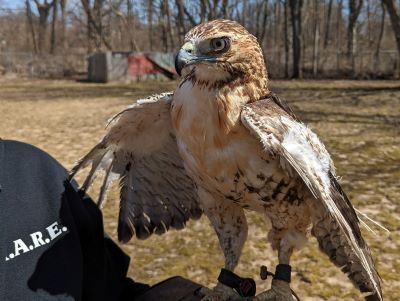
Good Natured: Caring for Icarus
Imagine this: You're driving along, minding your own business, when, wham! All of a sudden your vehicle is hit by a UFO: an Unidentified Feathered Object.
Now, usually, feathered objects flying through the air are pretty recognizable as, yes, birds. But in this particular case, the thing with feathers was unlike anything the driver had ever seen. It was white and brown and…smoldering…
It didn't take long to ascertain that this UFO was an immature red-tailed hawk that had made a misstep that nearly cost him his life. He'd flown just a little too close to a landfill flare—those flaming stacks that burn the methane produced by decomposing organic matter—and caught fire himself.
When birds and vehicles collide, the results usually aren't good. But for this hawk, the impact was the best thing that could have happened, considering the horrifying encounter that had already occurred.
The driver, recognizing that the bird needed help, contacted authorities and soon the young bird was in the caring and capable hands of KARE--Kane Area Rehabilitation and Education for Wildlife in St. Charles.
Last year this wildlife rescue group took in between 800 and 900 animals that found themselves in unfortunate circumstances, usually due to some sort of human action or interaction. Sure there were a substantial number of cases of mange and avian flu, but there were also hundreds of cases of critters tangled in fishing line, torn up by cats and dogs, hit by cars and trucks…you get the picture.
But last fall KARE received only one methane flare-toasted hawk, which came to be named, for recordkeeping purposes, Icarus. I remember hearing about the case when he arrived, and thought at the time his story would be worth sharing. He looked so awful, though, I wasn't sure what sort of ending his story would have.
The good news is, he's hanging in there. But the road ahead is a long one. (And costly. Many people believe that wildlife rescues receive government funding. However, other than the occasional grant, KARE and other centers like it rely on donations.)
Icarus sustained burns on his feet that, thankfully, have healed pretty well. His vision is being monitored too. But the biggest issue, and the one that's going to take time to regrow, is his seared plumage. Where he once had wing feathers and tail feathers, he now sports only singed shafts.
Over time his body will naturally undergo a process called molting, whereby old feathers fall out, individually, and over time are replaced by new ones. The only catch is, molts are triggered by a number of factors—seasonal changes in temperature and day length, for instance--none of which anyone has any control over.
And so Icarus and his curators wait. Lucky for him, he's getting the best of care.
John Papach, a KARE volunteer who's also a licensed falconer, set Icarus up in a special mew (the official name for a raptor enclosure). Because the bird was missing so many feathers, and cold weather had set in, John arranged to put the mew in his garage, where it would be shielded from bitter temperatures and wind.
A generous donor supplied a Home Depot gift card to purchase additional materials. John installed wind-blocking Plexiglas and insulated the area with thick sheets of polystyrene insulation; two large heat lamps helped ensure the ambient temperature didn't drop below 40F.
“We've had burned birds before, but never one like this," John says. “He flew into the car still on fire. We were just amazed at the depth of the burn. No part was untouched."
Proper nutrition is essential to healing, so John makes sure Icarus gets a quality diet of frozen, thawed mice and rats. Weighing 34 oz. at intake, Icarus now tops the scales at 40 oz., a healthy weight for a male redtail.
As he continues to care for Icarus, keeping an eye out for complications, John hopes the handsome hawk's story will call attention to a situation that's largely unrecognized: That methane flares, while important for human safety, exact a heavy toll on birds of prey—especially diurnal raptors that might not see the flames in bright sunlight. Compounding the problem, some landfills have flares that are intermittent. One minute the burner tube makes a fine perch; the next, it's a roaring inferno.
John says there's been some attempts at mitigating the issue, with a few landfills installing shields around their flares. And in some areas, the methane is being used as energy sources. But hundreds of others operate with no bird protections at all.
“We'd just like to up the awareness," John says. “It's a problem in need of a solution."
Readers who'd like to donate to Icarus's care may do so at KARE's Facebook page, https://www.facebook.com/KAREforWildlife
Pam Otto is the outreach ambassador for the St. Charles Park District. She can be reached at potto@stcparks.org.

